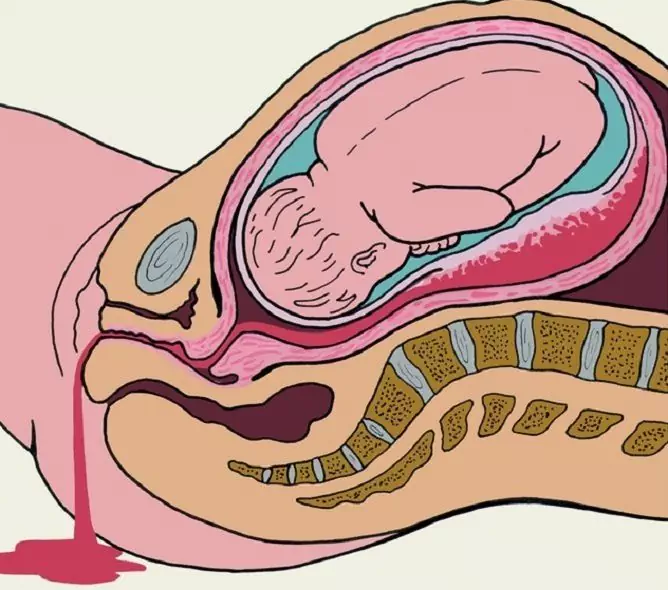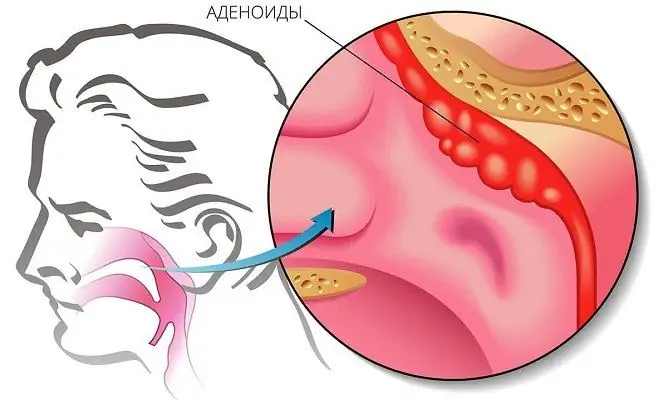- Author Rachel Wainwright [email protected].
- Public 2023-12-15 07:39.
- Last modified 2025-11-02 20:14.
Cardioneurosis
The content of the article:
- Causes and risk factors
- Symptoms of cardioneurosis
- Diagnostics
- Treatment of cardioneurosis
- Diet for cardioneurosis
- Alternative treatment of cardioneurosis
- Potential consequences and complications
- Forecast
- Prevention
Cardioneurosis is one of the varieties of "organ" neurosis, the development of which is caused by nervous and mental disorders. The pathology is widespread, according to various authors, symptoms of cardioneurosis of one degree or another are observed in 21-56% of the adult population. About 80% of patients undergoing inpatient treatment complain of neurotic pain in the region of the heart. About 35% of patients seek medical help due to manifestations of cardioneurosis.
ICD-10 classifies cardioneurosis as a psychosomatic disorder or autonomic somatoform dysfunction. This is due to the fact that in the development of the disease, both mental disorders and dysfunctions of the cardiovascular system play an equally important role.
Causes and risk factors
Various reasons can lead to the development of cardioneurosis, provoking too complex and severe irritation of the cortical structures of the brain.

Source: athina984.gr
Trigger factors can be:
- mental and physical trauma;
- sexual disorders;
- chronic intoxication (industrial toxins, alcohol abuse, smoking);
- a state of chronic stress (long-term conflict situations in everyday life or at work);
- prolonged insomnia;
- malnutrition.
In every second patient suffering from cardioneurosis, the examination reveals concomitant pathology:
- mitral valve prolapse (observed in about 30% of patients);
- arterial hypertension with frequent crises;
- mild angina;
- heart rhythm disturbances of unknown etiology (idiopathic arrhythmia);
- Wolff-Parkinson-White (WPW) syndrome, which is often associated with supraventricular tachycardia.
An important role in the development of cardioneurosis belongs to hormonal imbalance. Therefore, the disease is often observed in patients suffering from thyrotoxicosis, as well as in women during pregnancy and menopause.
Certain character traits also predispose to the development of cardioneuroses. According to psychologists, these features include:
- excessive self-control;
- increased suspiciousness, anxiety;
- lability of mood;
- a tendency to panic attacks.
Phobias (fear of the dark, crowds, confined spaces, heart attack, and others) also increase the risk of developing cardioneurosis.
Symptoms of cardioneurosis
The main symptom of cardioneurosis is pain in the region of the heart (cardialgia). A painful attack usually occurs suddenly and is accompanied by severe vegetative symptoms: cold sweat, tachycardia, fear of fainting or death, feeling of lack of air. The attack lasts from several minutes to several hours. The experienced discomfort is well remembered by patients. As a result, they fear a recurrence of the attack and at the same time constantly expect it with fear, especially in moments of physical overstrain or emotional stress. The anticipation of an event, for example, a public speech or a conversation with the authorities, can also provoke an attack. In this case, the occurrence of cardialgia is preceded by increased sweating of the palms, reddening of the face, increased breathing and heart rate.

The frequency of recurrence of attacks in cardioneurosis is different, in some they occur 2-3 times a year, while in others they can be repeated several times a day.
Pain in cardialgia can be aching or sharp, bursting or squeezing, throbbing, cutting, stabbing. It is not stopped by taking nitroglycerin. Often combined with a feeling of sinking heart or burning of the skin on the left side of the chest, headache. It can radiate to the back, neck, shoulder blade, genitals.
A characteristic feature of cardioneurosis is a vivid, detailed and imaginative description by patients of their state of health at the time of an attack (“the heart was squeezed in a vice,” “the heart was squeezed into a ball,” or “trembled like a fish's tail”). It is also interesting that with each new attack, the patient's interpretation of their feelings is somewhat different.
Patients with cardioneurosis during an attack are fussy, speech is accompanied by emotional gestures. In an effort to alleviate their condition, they take medications (nitroglycerin, validol, motherwort tincture, Zelenin drops), apply an ice bubble or, conversely, a warm heating pad to the chest, rush about, require immediate hospitalization in the intensive care unit.
In those periods of life, when patients are passionate about some business, the signs of cardioneurosis disappear.
Diagnostics
Cardioneurosis refers to behavioral and mental disorders, and not to diseases of the heart and blood vessels. In accordance with this, this diagnosis is not made by a therapist, but by a psychiatrist or neuropsychiatrist. However, since in the CIS countries the correct attitude of the population to psychiatry, including the small one involved in the therapy of neuroses, has not been formed, the diagnosis and treatment of patients with cardioneurosis is carried out mainly by therapists, cardiologists and neuropathologists at the polyclinic level.
Pain in the region of the heart always deserves the closest medical attention. A quick differentiation is required between the true cardialgia that occurs during an attack of angina pectoris, myocardial infarction and pain in the chest due to neuropsychiatric disorders. With true cardialgia, patients try to restrict movement as much as possible, since any physical activity provokes an increase in pain and shortness of breath. They always clearly describe their feelings, without using epithets and hyperboles.
Cardioneurosis can be assumed when the following signs are detected:
- pain in the heart that periodically appears or persists for more than three months;
- the presence of a clear connection between the appearance or intensification of symptoms of cardioneurosis with hormonal imbalances (puberty, pregnancy, menopause, thyrotoxicosis);
- labile blood pressure;
- recurring attacks of extrasystole and / or tachycardia;
- dysfunction of the autonomic nervous system (white persistent dermographism, cold extremities, general chilliness, a marbled shade of the skin, hyperhidrosis of the palms and feet);
- long-term bad or depressed mood.
To exclude organic heart diseases, a comprehensive examination is carried out, including:
- ECG (with cardioneurosis there are no signs of myocardial ischemia, such as changes in the ventricular complex and the T wave, a decrease in the ST interval);
- ECHO-KG;
- blood pressure monitoring and Holter ECG;
- cardio-load functional tests (bicycle ergometry, treadmill);
- a general blood test (with myocardial infarction, there is an increase in the activity of some enzymes, which is not observed in cardioneurosis).
Treatment of cardioneurosis
When assisting patients with an attack of cardioneurosis, one should be calm, try to distract the patient with a conversation from worries about his condition, since excessive excitement contributes to arousal, increased fears and, at the same time, the severity of the pain attack. If possible, the patient is placed in a separate, quiet, well-ventilated room, after which the pulse is counted and blood pressure is measured.

Source: sosudinfo.com
With severe arousal, one of the sedatives is prescribed (Persen, Valocordin, Novopassit, valerian extract in tablets). Before stopping an attack of cardioneurosis, you should not apply warm heating pads, ice packs to the extremities, massage or rub your hands and feet.
If, despite the ongoing treatment of cardioneurosis, the patient's condition does not improve or worsens, it is necessary to urgently call the ambulance team and hospitalize him in the cardiology department.
After the relief of the attack of cardioneurosis, sedatives continue to give another 1-2 days.
In the out-of-attack period, active therapy of neurosis is carried out. Medication therapy is selected for each patient individually by a neuropsychiatrist, taking into account the form of neurosis (hyper- or hyposthenic). With a pronounced fear of waiting for a recurrence of an attack, psychotherapy is indicated for patients.
Diet for cardioneurosis
Diet plays an important role in the complex treatment of cardioneurosis. Its purpose is to prevent overexcitation of the nerve structures of the cerebral cortex and improve blood circulation.
In the diet, the content of table salt, hot spices, smoked meats, pickles and marinades, chocolate, caffeine-containing drinks (strong tea, coffee, energy drinks) is limited. It is advisable to completely exclude from the diet foods that increase gas formation in the intestine, and thereby contribute to the occurrence of flatulence: legumes, pears, cabbage, grapes, all types of carbonated drinks.
Products with a high cholesterol content are also prohibited: sour cream, fatty cheeses, butter, offal, fatty meats, red and black caviar, chicken eggs.
For patients with cardioneurosis, a dairy-plant diet is recommended, including:
- skim cheese;
- well boiled porridge (oatmeal, buckwheat);
- fruits (kiwi, bananas, persimmon);
- dried fruits (raisins, dried apricots);
- low-fat cheese;
- natural yogurt;
- vegetable juices (celery, carrot);
- wheat bran bread.
Alternative treatment of cardioneurosis
Traditional medicine offers many remedies that have a sedative (calming) effect on the body. In consultation with the attending physician, some of them can be used in the treatment of cardioneurosis.
- Infusion of motherwort herb - prevents recurrence of attacks of cardioneurosis, improves sleep, relieves excessive tension. Pour one tablespoon of chopped motherwort herb with a glass of boiling water, leave for 30 minutes, then strain and add 30 drops of pharmacy alcoholic tincture of May lily of the valley to it. Take 5 times a day, 20 ml.
- 4 tablespoons of valerian root infusion, 2 tablespoons of peppermint leaves and fennel fruits each, 1 tablespoon each of May lily of the valley flowers and chamomile, chop and mix well. Take 2 teaspoons of this mixture and pour a glass of very cold water over it. Insist in a dark and cool place for 3-4 hours, then bring to a boil, cool and strain. Take 50 ml 3-4 times a day with a combination of symptoms of cardioneurosis and disorders of the digestive system.
- Take the infusion of hop cones, yarrow herb, lemon balm leaves and valerian root in equal amounts, mix well. Pour a tablespoon of the mixture with a glass of boiling water and leave for 30-35 minutes, drain. Drink the resulting infusion during the day in small sips. The tool has a pronounced sedative effect, helps to normalize sleep.
Potential consequences and complications
Cardioneurosis is far from a harmless disease. With a long course, it significantly increases the risk of developing coronary heart disease, including its most dangerous complication - myocardial infarction. The constant fear of a new heart attack disrupts patients' sleep, increases the severity of neurotic disorder, and contributes to the development of depression. As a result, the ability to work decreases, the quality of life of both the patient himself and his loved ones worsens.
Forecast
The forecast is favorable. With adequate treatment, following the doctor's recommendations for maintaining a healthy lifestyle, attacks of cardialgia become rare, and in many cases they gradually stop completely.
Prevention
Prevention of cardioneurosis includes the following measures:
- observance of the regime of alternation of work and rest;
- prevention of stress and physical strain;
- daily walks in the fresh air;
- cold and hot shower;
- regular physical education;
- quitting smoking and alcohol abuse;
- exclusion from the diet of foods and drinks that have an exciting effect on the central nervous system (chocolate, coffee, coca-cola).
YouTube video related to the article:

Elena Minkina Doctor anesthesiologist-resuscitator About the author
Education: graduated from the Tashkent State Medical Institute, specializing in general medicine in 1991. Repeatedly passed refresher courses.
Work experience: anesthesiologist-resuscitator of the city maternity complex, resuscitator of the hemodialysis department.
The information is generalized and provided for informational purposes only. At the first sign of illness, see your doctor. Self-medication is hazardous to health!






